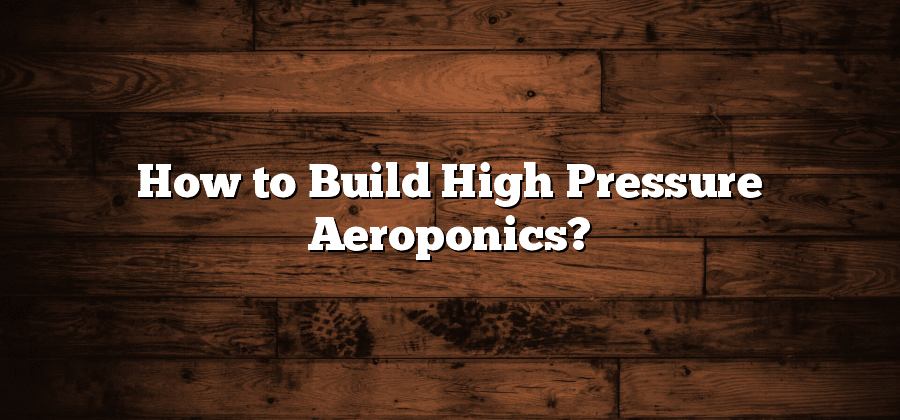Benefits of High Pressure Aeroponics
High Pressure Aeroponics offers a range of benefits that make it an attractive option for hydroponic enthusiasts and commercial growers alike. One of the main advantages is its ability to deliver nutrients directly to the roots of plants, promoting faster growth and higher yields. By misting a fine nutrient solution onto the roots, High Pressure Aeroponics ensures that every plant receives an equal amount of nutrients, eliminating the risk of over or underfeeding.
Another benefit of High Pressure Aeroponics is its efficiency in water usage. Compared to traditional farming methods, this system requires significantly less water to grow plants. The roots are misted with a precise amount of water, preventing any wastage or evaporation. This not only saves water, but also reduces the overall cost of production. Additionally, because the system operates in a closed environment, there is minimal loss of nutrients or water due to run-off or evaporation. This allows growers to conserve resources and practice sustainable farming methods.
Necessary Equipment for High Pressure Aeroponics
The success of a high-pressure aeroponics system is greatly influenced by the selection and use of the right equipment. To ensure optimal plant growth and productivity, there are several essential tools and components that every high-pressure aeroponics setup should have.
First and foremost, a high-pressure pump is a cornerstone of this type of system. The pump is responsible for generating and maintaining the high-pressure environment necessary for nutrient delivery to the plant roots. It is crucial to invest in a high-quality pump that can consistently and reliably maintain the desired pressure levels. Additionally, an appropriate pressure regulator is essential to control and adjust the pressure as needed, ensuring a stable and efficient system operation.
In addition to the pump and pressure regulator, a reliable and durable spray manifold is another vital component of any high-pressure aeroponics setup. The spray manifold is responsible for evenly distributing the nutrient solution to the plant roots. It should be constructed of high-quality materials that are resistant to corrosion and clogging, ensuring a continuous and efficient flow of the nutrient solution. Moreover, a well-designed nozzle system is essential to achieve a fine and uniform spray pattern, allowing for efficient absorption of nutrients by the plant roots.
A proper filtration system is also crucial in a high-pressure aeroponics setup. It helps remove any impurities or sediment that may interfere with the proper functioning of the system or clog the spray nozzles. Investing in a reliable filtration system will not only prevent damage to the equipment but also ensure that the plants receive clean and nutrient-rich water.
Lastly, a well-designed reservoir or tank is essential for storing and supplying the nutrient solution to the system. It should be constructed of food-grade materials and have proper sealing to prevent contamination. The reservoir should also have the capacity to hold an adequate amount of nutrient solution to sustain the plants for an extended period without the need for frequent refills.
Overall, selecting and using the necessary equipment for high-pressure aeroponics is crucial for the success of the system. Investing in high-quality components that are designed specifically for this type of cultivation method will not only ensure efficient nutrient delivery but also contribute to healthier and more productive plants.
Choosing the Right Location for Your Aeroponics System
Selecting the ideal location for your aeroponics system is crucial for its success. The first aspect to consider is the availability of sunlight. Aeroponic plants require a sufficient amount of natural light to carry out photosynthesis effectively. Therefore, it is recommended to position your aeroponics system in an area that receives at least six hours of direct sunlight each day. This could be a south-facing window or a spot in your garden that offers ample exposure to the sun.
In addition to sunlight, it is important to consider the accessibility of water and electricity. Aeroponic systems require a continuous supply of water and an electrical source for the pump to function properly. Thus, it is advisable to select a location that is in close proximity to a water source, such as a sink or a hose, as well as an electrical outlet to ensure convenient maintenance and operation of your aeroponics system.
Preparing the Water Solution for High Pressure Aeroponics
To achieve optimal results in high-pressure aeroponics, preparing the water solution is a crucial step. The water solution serves as the medium for delivering nutrients to the plants’ roots. It is essential to create a well-balanced and nutrient-rich solution to ensure vigorous plant growth and maximize yields.
The first step in preparing the water solution is to measure the appropriate quantities of nutrients. This involves carefully following the instructions provided by the nutrient manufacturer and accurately measuring the required amounts. It is advisable to use high-quality nutrients specifically formulated for aeroponic systems to ensure the plants receive the necessary macro and micronutrients. Once the nutrients are measured, they can be added to the water reservoir and mixed thoroughly to ensure even distribution. Regular monitoring and adjustment of the water solution’s pH level is also vital, as aeroponic systems typically require a slightly acidic pH range for optimal nutrient uptake by plants.
Designing and Building the Aeroponics Chamber
To ensure the success of your high pressure aeroponics system, designing and building the aeroponics chamber is a crucial step. This chamber is where your plants will be suspended and nourished by a fine mist of nutrient-rich water. The design of the chamber should promote healthy plant growth while providing adequate support and protection.
When designing the aeroponics chamber, consider the size and shape that will best accommodate your plants. It should be spacious enough to allow for root expansion and easy access for maintenance tasks. Additionally, the materials used should be durable, non-toxic, and resistant to corrosion. The chamber should be properly sealed to prevent any leaks or contamination. Adequate ventilation and proper airflow must also be ensured to maintain optimal growing conditions for your plants.






